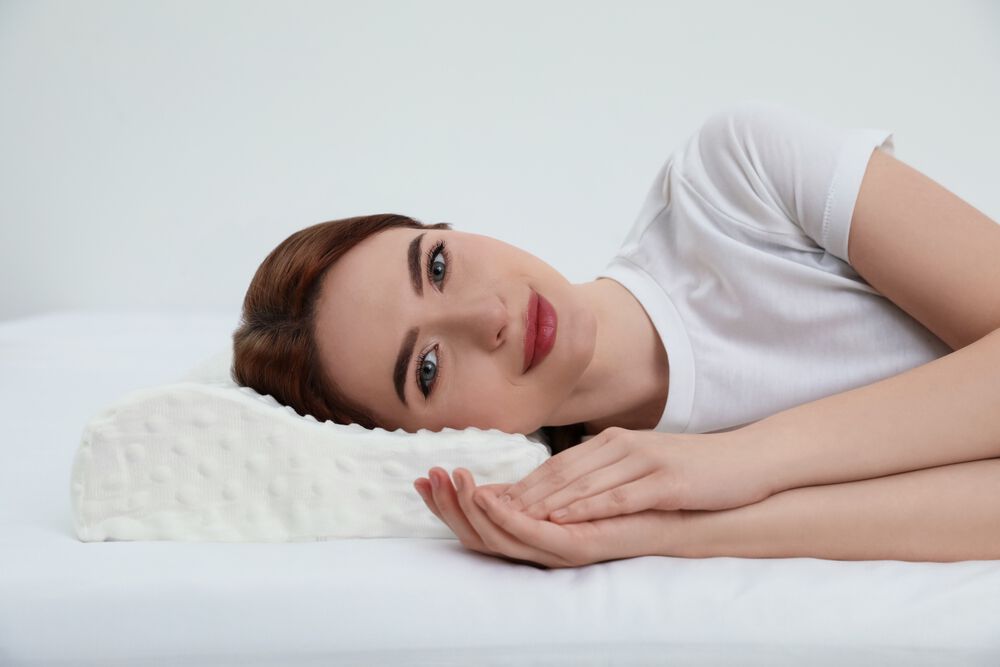If you’re shopping for mattresses, you know that buying one is no small feat. With the long-term relationship you’ll build with a mattress, purchasing one is more like welcoming home a new member of the family. As such, it’s essential to choose the best mattress type that meets all of your sleep and pressure relief requirements.
Those in search of a material that strikes the fine balance between comfort and support are likely to land on memory foam. Memory foam mattresses are a hot commodity—and for good reason. The best memory foam mattress selections are comfortable, they’re plush, and they can provide you with endless nights of satisfactory sleep.
What is memory foam, exactly? It’s a question you wouldn’t be alone in asking—so we’ve gathered everything you need to know about this popular mattress type.
What Is Memory Foam?
Memory foam isn’t just any foam—it goes much deeper than that. At its foundation, it’s made from polyurethane, a versatile plastic polymer that manufacturers use in various products, from sofas and mattresses to spray foams and car parts.
In addition to polyurethane, memory foam also contains other chemicals that increase the elasticity, density, and viscosity of mattresses. The result? Memory foam’s unique ability to contour your body better than many other materials on the market.
Of course, not all memory foam mattresses are created equal. Hence, the question: how long do memory foam mattresses last?
Many traditional memory foam mattress manufacturers concoct their own secret recipes with varying ingredients and processes that help them craft what they deem the ultimate and best memory foam mattress. These minor alterations from the traditional memory foam mattress change the overall functionality and texture of their memory foam beds and offer exceptional perks, depending on your sleep style and preferences.
Memory Foam: A Brief History
As grateful as we are for the comfort and support that memory foam mattresses offer night after night, interestingly, this special blend of materials was originally concocted not for sleep, but for space. Researchers developed this particular foam in the 1960s for some of NASA's spacecraft seats. They intended for the foam to provide further protection to pilots by:
- Absorbing shock
- Relieving pressure
- Providing additional comfort
It wasn’t until the 1990s that memory foam found purpose in another worthwhile cause: helping slumberers all over the world obtain higher-quality sleep.
With the introduction of the Tempur-Pedic mattress, memory foam breathed new life into the mattress industry. After only three years of being in the U.S. market, the Temper-Pedic mattress generated more than $6 million in sales.
In the years following, other mattress brands have followed suit by creating their own versions of NASA’s original Tempur foam. Using their initial formula, they’ve made adjustments with elements such as:
- Gel
- Plant-based materials
- Copper
How Does Memory Foam Work?
Thanks to polyurethane and a handful of other materials, memory foam mattresses mold themselves in response to applied pressure. That means when you lie on the mattress or memory foam mattress topper, it’ll conform to your body, giving you a luxurious level of comfort and support.
Memory foam beds are also affected by temperature. When you lay on the surface of a memory foam mattress, your body heat affects the materials' viscosity. The longer you lay on it, the more your temperature heats the foam, allowing it to flex and conform even more closely to your joints and muscles.
What Are the Benefits of Memory Foam?
When it comes to deciding between a hybrid mattress vs memory foam mattress, there are advantages aplenty. From their durable design to their quiet temperament, here are some of the most alluring benefits to look forward to if you opt for memory foam.
They Relieve the Discomforts of Pressure
Perhaps the most enticing of all the benefits of memory foam for sleepers is its ability to relieve pain. Whether you’re healing from an injury, expecting a child, or dealing with muscular or joint discomfort, an extra-supportive bed can mean the difference between a sore day and a stellar one.
What’s more, when you’re sleeping on a dated mattress, it can exacerbate your discomfort in areas where you place the most pressure, including your:
- Neck
- Shoulders
- Hips
- Knees
- Shoulders
If you suffer from arthritis or joint pain, continued pressure in those areas can cause unnecessary pain throughout the night or after you wake up.
With a memory foam mattress, however, your body heat helps the foam contour to your unique shape. As it molds to you, the mattress more evenly distributes your body weight and relieves the pressure throughout your body, allowing for a night of tension-free sleep and a morning feeling refreshed and rejuvenated.
They Support Spinal Alignment
Memory foam is crafted to sculpt your body like a well-fitted glove, so it responds to each of your curves, including your spine and lumbar (where the largest curve of your back lies). This provides better support for your spine and helps to relieve stress and strain you might notice on less-conforming mattresses.
They Reduce Motion Transfer
We’ve all been there. It’s 3 a.m., and you’re in the middle of a peaceful slumber. Suddenly, your partner stands up to use the bathroom, shaking the entire mattress as they go—leaving you jostled and wide awake.
With a memory foam mattress, you or your partner can easily peel yourselves from the bed without worrying about waking one another. That’s because memory foam’s density is able to absorb pressure where movement occurs so that any motion is contained to that specific location.
They’re Noise-Free
Speaking of interruptions that wake you up at night if you have shuffling kids or partners who toss and turn frequently in bed, a squeaky mattress is less than ideal. Those noises from a spring mattress don’t lend themselves to a solid night of sleep.
Memory foam puts excess noises to bed with its spring-free design.
Unlike a spring mattress, memory foam mattresses are notorious for being supportive and silent so that you can enjoy a full night of sleep with no interruptions from your sleep surface—only complete tranquility in their cloudlike softness.
They’re Hypoallergenic
The density of the memory foam, and its allergen-resistant materials leave little room for dust or bacteria to grow. They also make it more challenging for unwanted dust mites to dig their way into your mattress and set up camp where they’re not welcome. Sufferers of allergies or asthma (or those who just prefer a clean sleep surface) will surely appreciate this understated advantage.
Types of Memory Foam
If the idea of sleeping on a luxurious cottony cumulus entices you, you’re not alone. From the tried-and-true traditional memory foam to more contemporary styles, here are some of the most popular types of memory foam to consider.
Traditional Memory Foam
It’s a classic for a reason. Made of multiple layers of foam, the traditional style boasts all the benefits promised by a memory foam mattress, including:
- Contouring – The second you cozy yourself onto the mattress, you’ll feel the mattress slowly conform to every angle and curve of your body, providing optimum support and pressure relief.
- Sinking – Prepare to be welcomed into your bed with a warm embrace as you sink into blissful comfort. If you appreciate the feeling of sinking into a celestial haven, a memory foam mattress will not disappoint.
Gel Memory Foam Mattress
Gel memory foam mattresses gained popularity in the early 2010s for their ability to help hot sleepers remain cool as they slumbered. These types of mattresses are similar to traditional memory foam but infuse gel-based microbeads into the mattress to absorb the heat from your body. A gel memory foam mattress also provides a lower surface temperature throughout the night.
In addition to traditional or gel memory foam mattresses, there are many other popular options to consider as well, including:
- Air-cooling – This type of memory foam often infuses copper wire into the mattress to conduct energy away from your body and keep you cooler.
- Plant-based – For a more sustainable option, consider plant-based memory foam. Instead of using petroleum as a main ingredient, this style of foam utilizes eco-friendly plant-based oils.
- Open-cell – Open-cell memory foam is similar to the traditional kind but boasts internal pockets (aka open cells). These cells permit a smoother airflow and are more thorough at dispersing heat than traditional memory foam, which can sometimes feel too warm for hot sleepers.
Find Your Perfect Memory Foam Mattress at Mancini’s Sleepworld
The average person spends approximately one-third of their life sleeping. That’s why it’s essential to embrace your inner Goldilocks so you can find the mattress that’s just right for you. But you shouldn’t have to spend hours scouring the internet to find the perfect one—and at Mancini’s Sleepworld, you won’t have to.
Consider us your mattress matchmakers. We’re happy to help you find a mattress that checks all of your boxes. And if you’re not quite sure what those boxes entail, our SleepMatch technology can assist you in finding exactly what you didn’t know you needed. Using 3D scanning and pressure-sensitive technology, it scientifically measures your sleep needs to determine the ideal mattress for your body.
Whether you’re destined for a memory foam mattress, a hybrid mattress or something in between, we offer a wide selection of premium quality mattresses from the top brands in the industry.
A better you starts with better sleep. Find your perfect match and buy mattresses online at Mancini’s Sleepworld today.
Sources:
- Sleep Foundation. When Should You Replace Your Mattress? https://www.sleepfoundation.org/mattress-information/when-should-you-replace-your-mattress
- NASA Spinoff. Forty-Year-Old Foam Springs Back With New Benefits. https://spinoff.nasa.gov/Spinoff2005/ch_6.html
- Vox. What do a mattress and a seat in a NASA aircraft have in common? Turns out, a lot.https://www.vox.com/ad/17980476/tempur-pedic-mattress-nasa-science-innovation
- NIH. How Much Sleep Is Enough? https://www.nhlbi.nih.gov/health/sleep/how-much-sleep

